Pizza crust may sound like the perfect treat for your pup, but it’s more complicated than that. Furthermore, pizza crusts usually contain ingredients such as garlic or onion powder, which are toxic to dogs.Even cheese and sauces may make their tummy hurt. If your pup manages to swipe a slice, don’t panic. Keep a close eye on them for any adverse reactions, such as vomiting.If you’re ever concerned, call your vet for guidance. Pet safety is important, so don’t leave pizza lying around.
Key Takeaways
- Pizza crust is generally safe for dogs in moderation. Watch for signs of digestive upset and avoid crusts with fatty toppings.
- However, feeding your dog regular doses of pizza crust is dangerous to their health. The high-fat content from the cheese can cause weight gain and pancreatitis. As always, moderation is the answer.
- Garlic, onion, and processed cheese can cause food sensitivities or allergic reactions to develop.
- Dogs most likely will have lactose intolerance, so cheese is another ingredient that could be a problem. choose dog-safe cheese substitutes when you can.
- Plus raw pizza dough is also very dangerous for dogs because it can expand inside their stomachs, So, make sure any dough you share is fully cooked, or use dog-friendly recipes.
- If you do feed your dog pizza, watch for symptoms like vomiting or lethargy. If you do observe any dangerous reactions, take your dog to a vet as soon as possible.
Can Dogs Eat Pizza Crust?
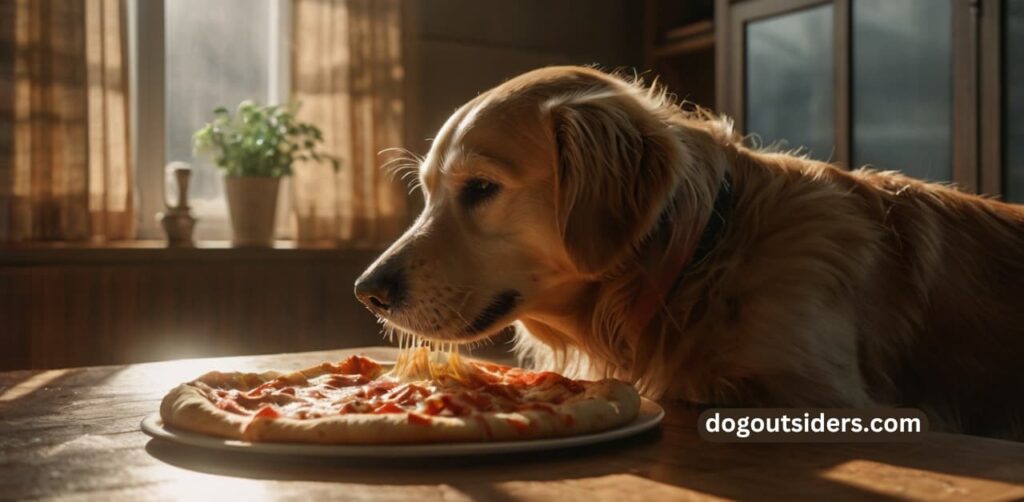
1. Is Pizza Crust Safe for Dogs?
In general, when it comes to sharing the occasional pizza crust with your dog, moderation is the best approach. So plain pizza crust in small amounts is safe, similar to giving your dog an occasional treat. I know most dog owners, myself included, have treated our four-legged companions to a bite from the table.
It isn’t surprising to see dogs savoring a slice of crust. Whatever the topping, you should always watch your dog closely for any sign of digestive distress. Even a tiny portion of food can cause these problems.
If the crust has a lot of fatty toppings, such as extra cheese or greasy meats, this can be more dangerous and should be avoided. It’s always best to consult with your veterinarian for personalized advice, to ensure your dog’s dietary needs are met safely.
2. Why Pizza Crust May Harm Dogs
Pizza crusts, particularly if they’re heavy with fats, can cause some serious issues in dogs. Similar to humans, canines can suffer from obesity and other negative health effects after indulging in decadent treats.
If pizza crust is fed regularly, that can lead to weight gain that you don’t want. In more serious situations, overindulgence can result in pancreatitis, a painful and life-threatening condition.
This makes moderation even more important, making treats such as pizza crust occasional indulgences instead of everyday treats.
3. Are Pizza Ingredients Harmful?
Unfortunately, some other common pizza ingredients can be toxic to dogs. Even a little bit of garlic, such as one clove, can cause an upset stomach for dogs. It can also cause other reactive effects within them.
Other ingredients, such as raw bread dough, can lead to intoxication, which can be life-threatening. So take those risks into account whenever you decide to share human food with dogs—even when it comes to pizza!
Reading ingredient labels more closely is always a good rule of thumb, though, preventing you from mistakenly harming your pet. Being aware of food sensitivities and potential allergens in dogs can help you make safer food-sharing decisions.
4. Can Dogs Eat Pizza with Cheese?
As much as you’d love to share your cheesy pizza with your dog, this is usually not a good idea. However, the high-fat content in cheese can be an issue, especially for dogs with sensitive stomachs.
It’s also worth noting that many dogs are lactose intolerant, so foods that contain dairy—like pizza with cheese on top—can cause some serious digestive upset. Cheese can make these issues worse, resulting in gas, abdominal pain, or a more severe digestive problem.
Instead of cheese pizza, instead try something like these dog-friendly cupcakes that are specifically tailored to their dietary needs.
Harmful Ingredients in Pizza
We know that many of you are just as much pizza lovers as we are, especially when it comes to enjoying delivery pizza. However, when it’s time to share this scrumptious delight with our furry friends, we must be cautious about the common harmful ingredients in pizza that can be dangerous to dogs.
| Ingredient | Risk Category | Examples |
| Garlic & Onion | Toxic | Garlic powder, onion rings |
| High-fat Meats | Unhealthy | Pepperoni, sausage |
| Processed Cheese | Digestive | Mozzarella sticks, cheese blends |
| Salt & Sugar | Toxic | Salted crust, sugar in sauces |
Garlic and Onion Risks
Garlic and onions in all forms, whether raw, cooked, or powdered, are highly toxic to dogs. Even in miniscule amounts, it can damage their red blood cells, resulting in anemia. Signs of poisoning include vomiting, weakness, and rapid heart rate.
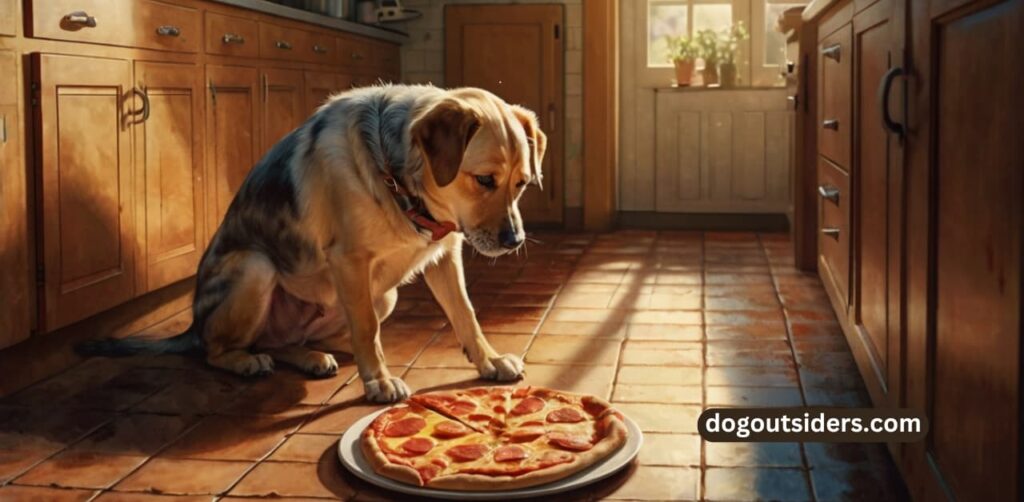
That’s why it’s so important to speak out against pizza sprinkled with these nasty ingredients. Instead, try adding flavor with herbs like basil or oregano instead—none of the harmful risks, all of the taste!
Salt and Seasoning Dangers
Pizza is often topped with salt, which can be dangerous to dogs. Excessive sodium consumption can lead to dehydration and, in extreme circumstances, salt poisoning. Dogs eating a lot of salt can show signs including increased thirst, vomiting, and even kidney damage.
When preparing homemade dog treats, choose low-sodium ingredients to keep your dog happy and safe.
Cheese and Dairy Concerns
Most dogs can’t resist cheese, but you need to think about your dog’s digestive system. Many dogs are lactose intolerant, and cheese-heavy pizzas will cause them an upset stomach or worse- diarrhea. Feeding your dog a small piece of cheese from time to time is perfectly fine.
Avoid giving your dog pizza if he’s sensitive to dairy. If you’re treating them on special occasions, opt for dog-safe cheese substitutes that align with their dietary requirements.
Issues with Pizza Dough
Another aspect that makes raw pizza dough dangerous, especially doughs made with yeast, is the risk of expansion. If eaten, it can expand in a dog’s stomach, leading to potentially fatal bloat and discomfort.
According to the ASPCA, raw dough can actually cause alcohol poisoning. To avoid these concerns, make sure that pizza dough is fully cooked before sharing a slice with your pup.
Or you can come up with unique dog-friendly dough recipes that are safe and delicious.
Other Pizza Risks for Dogs
While the crust is a major concern, there are other pizza-related hazards to consider. We know that the majority of dog owners enjoy sharing their dinner table snacks with their canine companions. It’s important to understand that things that are perfectly safe for us can be toxic to dogs.
Here are some additional risks associated with pizza foods:
- A sudden influx of greasy leftovers can also cause an upset stomach, or worse, pancreatitis.
- Pizza is high in calories which can lead to weight gain and obesity.
- Additives such as garlic and onions, even in small quantities, can result in gastrointestinal distress.
- Allergic reactions to certain pizza ingredients, like cheese or wheat, are also a risk.
That means portion control is very important if you choose to give your dog a tiny piece of pizza. Overfeeding can also cause a host of health problems just like in humans, including obesity and metabolic disorders.
Dangers of Pizza Sauce
Pizza sauce, a primary ingredient of this favorite dish, may include dog dangerous ingredients. Other common pizza components such as garlic and onion can be toxic as well. Garlic, particularly in concentrated forms, is especially deadly.
Just one clove can cause severe health issues. The acidity of tomato sauce is bad enough that it’ll get to a dog’s digestive system. This irritation can lead to pain or potentially severe digestive issues.
Most commercial sauces also have added sugars and preservatives. These unhealthy ingredients also contribute to weight gain and other serious health concerns. If you want to have a pizza party with your pets, consider making homemade, dog-friendly pizza sauce. It’s a healthier, more fun, and safer option!
Problems with Toppings
Toppings are another place where pizza can get risky for dogs. Popular toppings such as pepperoni and sausage add a ton of fat and salt. Eating them regularly can lead to obesity, diabetes, and other serious health issues in the long run.
Spicy or heavily seasoned toppings can lead to gastrointestinal upset in dogs. Choose better pizza options for your dog! Opt for better options, such as unseasoned, boneless cooked chicken or baby carrots.
Additional Risks from Pizza Foods
Even outside of the typical slice, there are other pizza-related foods that can be dangerous to dogs. Consider the following items:
- Many pizza rolls and other frozen convenient snacks include these harmful additives and preservatives.
- Second, leftover pizza crusts are often salted and fatty.
- Raw bread dough can lead to alcohol poisoning, something that the ASPCA is well aware of.
These risks can be avoided if pet owners refrain from feeding these foods to their dogs. So remain on the lookout for secret dangerous toppings! Consulting with a veterinary professional is always a good idea when figuring out what’s safe for your pet.
What to Do if Dog Eats Pizza
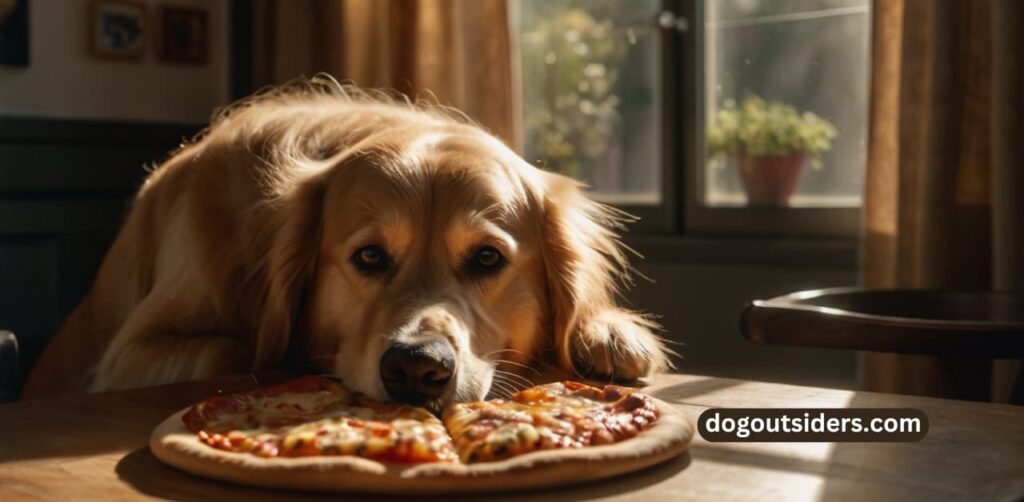
Immediate Steps to Take
If your dog has already eaten pizza, time is of the essence so you need to know what to do right away. Here’s what to do if your pup dives into the pizza.
- Consider the situation. Consider whether your dog just ate the crust or an entire slice, including toxic toppings such as onion, garlic, or toxic cheese. Before using any other methods next, make sure you clear the rest of the pizza from your dog’s reach.
Make sure your dog drinks plenty of water to help digestion and flush out any harmful ingredients. Monitor them closely for any signs of distress or odd behaviors such as drooling or pacing. This quick action can save your dog’s life, and that’s a big deal!
When to Contact a Vet
Understanding when to contact an emergency veterinarian is essential. If your dog develops concerning symptoms like vomiting, diarrhea, or lethargy, it’s best to consult a veterinarian immediately.
If symptoms linger or if they have a severe reaction such as trouble breathing or repeated vomiting, urgent care is needed. Keeping your vet’s contact information close at hand makes sure you get expert advice right away.
If you’re unable to access emergency veterinary care and your dog is in moderate pain, you can begin giving your dog a small dose of Aspirin mixed with food. Call your vet right away to talk about creating a tailored treatment plan. Don’t forget that online services like JustAnswer provide prompt answers from veterinary specialists and can be a great resource
Monitoring Your Dog’s Health
Once the immediate crisis has passed, though, you’ll want to monitor your dog’s physical condition closely. Signs to monitor include pain, lack of appetite, or behavioral changes such as lethargy or pacing.
A helpful checklist of symptoms such as vomiting, diarrhea, and lethargy can keep you updated on your pup’s well-being. If this happened a few days ago, don’t panic! If he’d been pooping regularly, the crust has almost certainly gone through his system.
Monitor your pup closely for any late-appearing symptoms. For the next few weeks, limit activities that may put extra stress on their system, like running or jumping. Consistent veterinarian visits are important in keeping your dog healthy and catching any underlying problems early on.
Safe Alternatives for Dogs
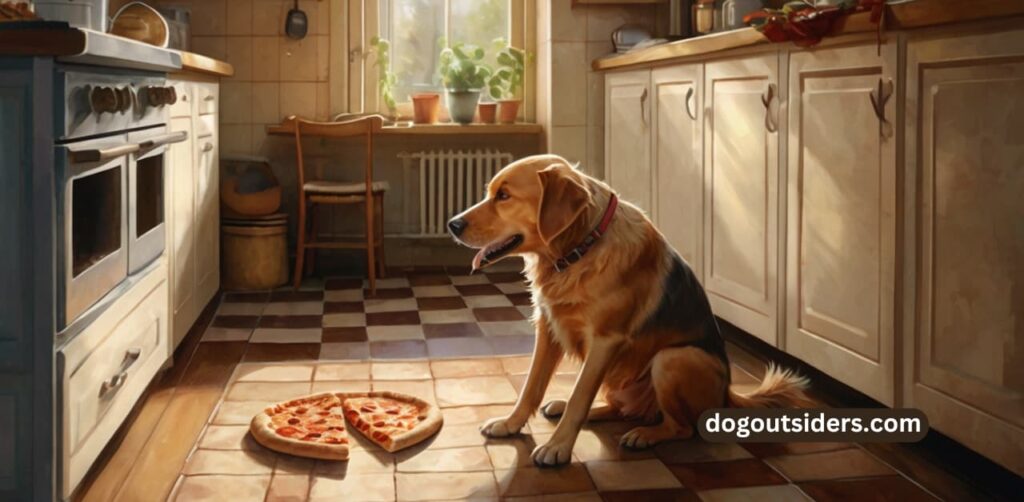
Healthy Snack Options
As we look for healthy snacks for our four-legged companions, it is important to choose treats that are not only safe, but beneficial for them. Dogs may love the smell of a hot pizza just out of the oven, but their wellbeing should never be compromised.
Pizza crust may seem like a harmless treat, but there are many healthier dog-friendly snacks to share. Here’s a handy bullet list to keep in mind:
- Crunchy and full of vitamins, carrots make a great snack.
- A sweet treat, but ensure you remove the seeds.
- Green Beans: Low in calories and packed with fiber.
- Blueberries: Small, tasty, and full of antioxidants.
- Specially made to meet dogs’ nutritional needs.
Having these snacks in rotation can help you keep nutrition in check and balance out a mostly healthy diet. Providing a range of flavors and textures will add to their eating experience.
This delights their palates, but more importantly it helps them thrive.
Homemade Treat Ideas
Making your own treats at home is an awesome way to make sure your dog is getting safe, healthy snacks. When you prepare treats at the house, you get full power over the materials.
This gives you the opportunity to avoid dangerous ingredients that are commonly found in pre-made varieties. Here are a few simple recipes you can try:
- Mix whole wheat flour, peanut butter, and water, then bake.
- Combine canned pumpkin, oats, and an egg for a tasty snack.
- Use rolled oats, applesauce, and a hint of cinnamon for flavor.
Each of these delicious recipes will bring exciting nutrition to your dog’s diet while giving you the opportunity to flex your culinary muscles. Finding new, creative, safe alternatives to the traditional treat can make treat time even more fun for you and your pup.
It’s a great way to connect while training for a fun and rewarding activity!
Remember, treats should make up no more than 10% of your dog’s daily calories. Even the healthiest foods contribute to weight gain when you go overboard!
Now, moderation is very important. If your dog is ever quick enough to snatch a slice of pizza, don’t panic – just monitor your pup closely for any signs of distress.
In fact, raw bread dough could be especially hazardous, even leading to intoxication at times. Make your dog’s health first by using safe alternatives for dogs.
Conclusion
Dogs will love pizza crust, but it’s not a healthy snack option. While pizza crust isn’t toxic, the common ingredients found in pizza pose a danger to your dog. Garlic, onions, and excessive salt are also health hazards. Even cheese is risky since dogs are lactose intolerant. Your dog might act okay immediately after eating pizza, but don’t be deceived. If they continue to consume it, they may have severe health issues in the future. Pizza crust has no nutritional value, so it’s not a good option for dogs. Instead, stick to lean meats or plain cooked veggies for a more healthy and safer choice. My advice is to keep pizza away from dogs and to limit treats to those made specifically for canine consumption. Dogs deserve treats that are just as delicious as they are nutritious.
Frequently Asked Questions
So can dogs eat pizza crust? Pizza crust, often found in delivery pizza, typically contains dog-toxic toppings like garlic and onion, making it unsuitable food for pets.
Not to mention, most dogs are lactose intolerant, and fatty cheese will upset their delicate tummies, so don’t feed them fatty food.
Always watch your dog after feeding them anything new, like pizza rolls or leftover crusts, for signs of danger. Symptoms such as vomiting or diarrhea require urgent veterinary care, especially with fatty cheese or toxic ingredients.
Safe plain cooked meat with no seasoning is a suitable food choice. Always opt for quality dog food or dog pizza rolls formulated for their dietary needs.
However, pizza toppings like onions, garlic, and certain spices can be toxic. To ensure your dog’s safety, it’s best to avoid giving them any delivery pizza or leftover pizza crust.
Pizza dough, especially from delivery pizza, may bloat a dog’s stomach as the dough can grow once inside, making it a potentially deadly food that needs urgent veterinary treatment.
Instead, opt for dog-safe treats such as carrot sticks or apple slices. These are all healthy treats, safe alternatives to human foods like pepperoni pizza.
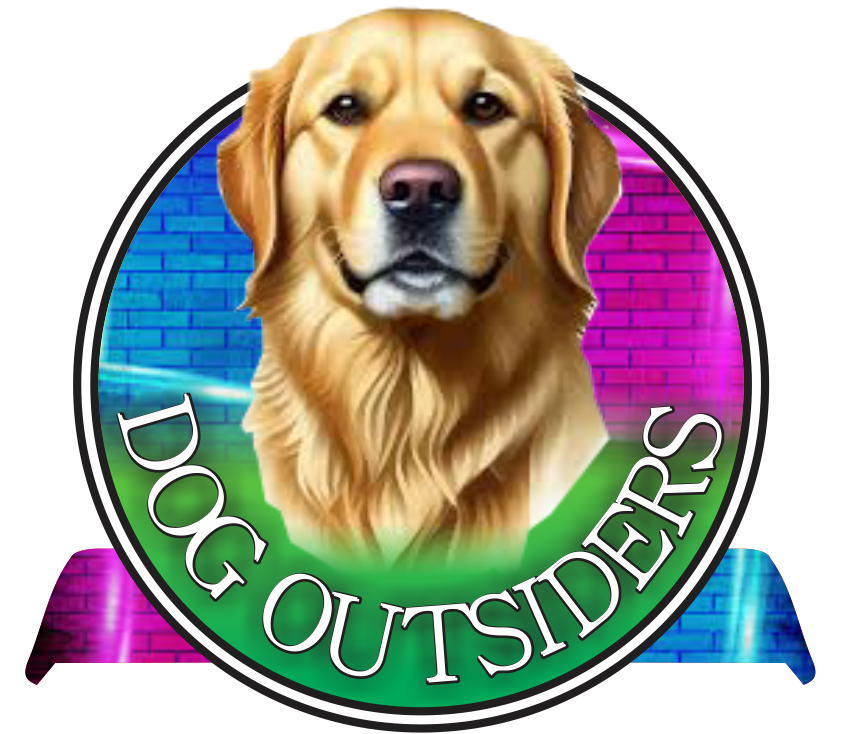


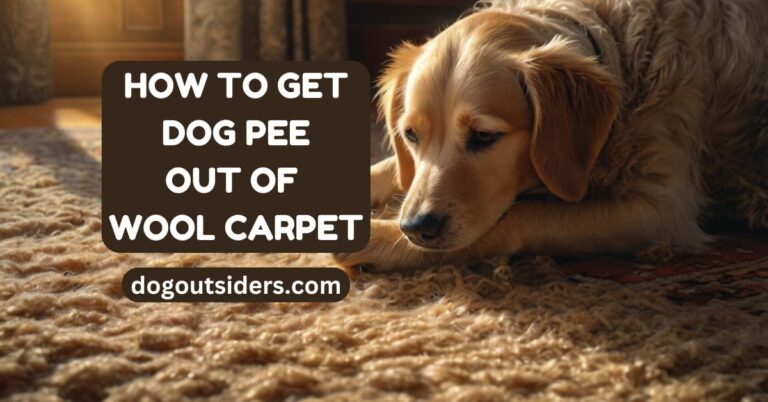

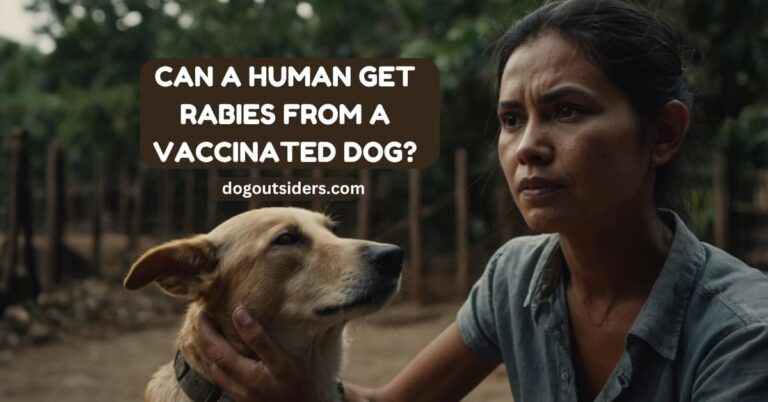

One Comment